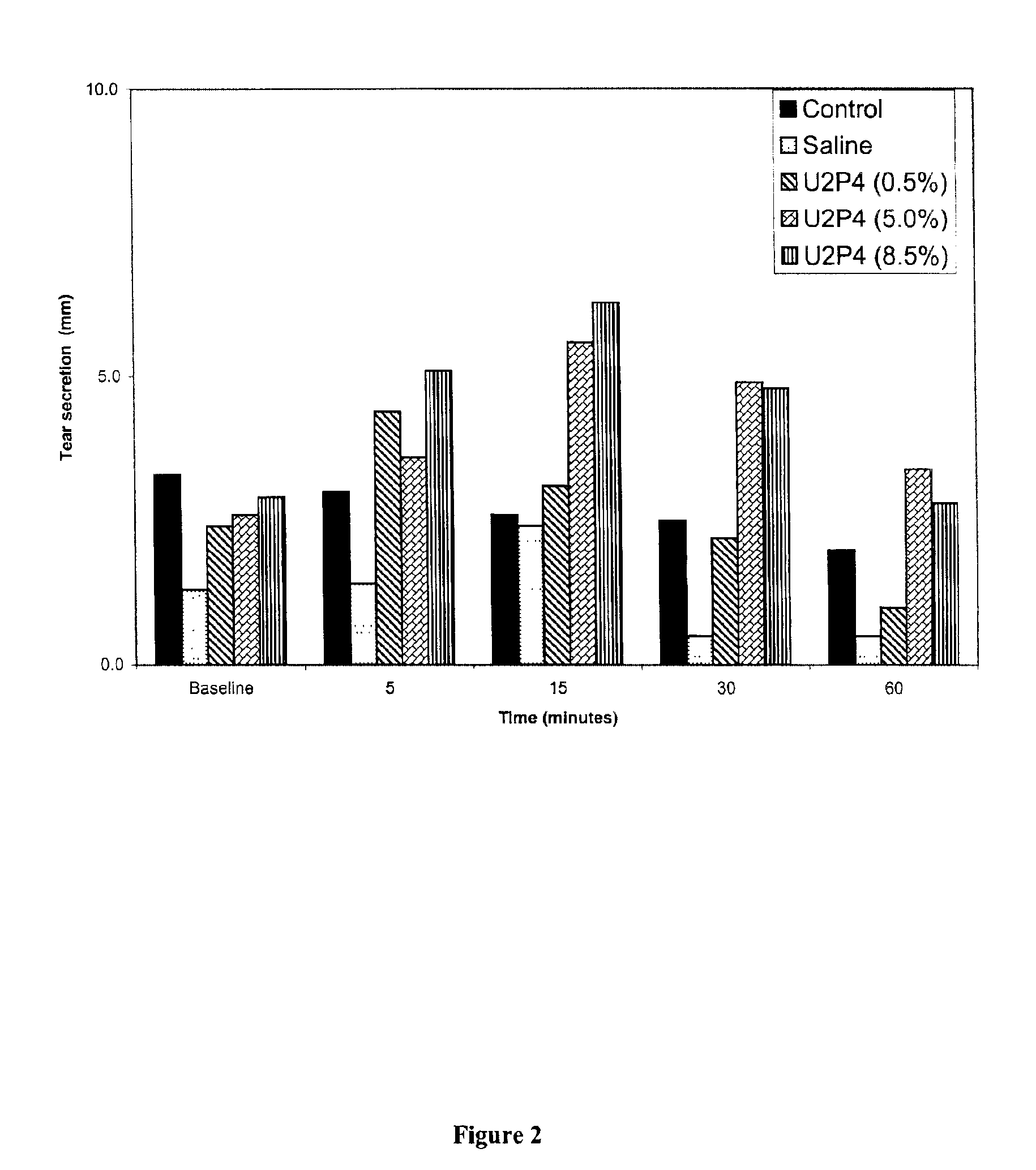Method of enhancing drainage of lacrimal system with purinergic receptor agonists
a technology of purinergic receptor and lacrimal system, which is applied in the direction of aerosol delivery, inorganic non-active ingredients, drug compositions, etc., can solve the problems of frequent dosing, short relief time, and limited pharmaceutical treatment of dry eye disease, and achieve the effect of stimulating tear production and enhancing the clearance of nasolacrimal ducts
- Summary
- Abstract
- Description
- Claims
- Application Information
AI Technical Summary
Benefits of technology
Problems solved by technology
Method used
Image
Examples
example 1
Stimulation of Mucin Release in Rat Conjunctival Preparations
[0072]Male, Sprague-Dawley rats at 12 weeks of age (Charles River Laboratories, Wilmington, Mass.) are sacrificed by intraperitoneal injection of sodium pentobarbital (1300 mg / kg) and a 20 μL drop of 1% lidocaine diluted with tear buffer (106.5 mM NaCl, 26.1 mM NaHCO3, 18.7 mM KCl, 1.0 mM MgCl2, 0.5 mM NaH2PO4, 1.1 mM CaCl2, and 10 mM HEPES pH 7.45) is placed on the ocular surface for 10 min. The inferior conjunctiva extending from lid to cornea and medial to lateral canthus is removed from each eye and placed on filter paper. Each conjunctiva is cut in half longitudinally and the four resulting pieces are incubated in keratinocyte growth medium (Clonetics Corp., San Diego, Calif.) with or without agonist for 1 hr at 4° C. in half strength Karnovsky's solution (2.5% glutaraldehyde and 2% paraformaldehyde in cacodylate buffer, pH 7.4), embedded in methacrylate, and sectioned into 3 μm pieces. Six sections from each piece of...
example 2
Measurement of Intracellular Calcium
[0073]Rat conjunctival cells grown on vitrogen coated coverslips are loaded with a final concentration of 3 μM Fura-2 / AM at 37° C. for 30 min. The cells are then washed in NaCl ringer and mounted in a chamber for measurement of fluorescence. To reduce the rate of leakage of Fura-2 from the cell into the extracellular space and avoid time-dependent compartmentalization of the probe, all measurements of [Ca2+]i are conducted at 25° C. At this temperature, no vesicular bright spots indicative of compartmentalization of the probe are observed.
[0074]Measurements of [Ca2+]i in single rat conjunctival epithelial cells are obtained with a modular microspectrofluorometer (SPEX Industries, Inc., Edison, N.J.) attached to a Zeiss Axiovert IM 35 microscope. The system is equipped with a xenon lamp, beam splitter, two monochromators and a rotating chopper mirror that permit excitation of cell fluorescence at alternating wavelengths of 340 and 380 nm (emission ...
example 3
Reversing the Onset of Dry Eye Disease in Rabbit Model for KCS
[0076]Keratoconjunctivitis sicca (KCS) is created in the right eyes of 8 New Zealand white rabbits by surgically closing the lacrimal gland excretory duct, and removing the nictitating membrane, nictitans gland and Harderian gland. All rabbits are left untreated for 8 weeks and KCS is confirmed by measuring elevated tear film osmolarity by taking 0.1-0.4 μL tear samples as previously described (J. Gilbard, et al., Ophthalmol. 96, 677 (1978)). A 3.0 mmol solution of UTP or analog is prepared in a preserved, isotonic buffer solution. Four of the rabbits are treated with 1 drop (10 μL) UTP or analog solution four times a day, excluding weekends. The remaining 4 untreated rabbits serve as controls. After treatment began, 0.1-0.4 μL tear samples are taken from all rabbits for osmolarity measurements on Monday mornings before the first dose. At 20 weeks the animals are sacrificed and goblet cell densities are measured by staini...
PUM
| Property | Measurement | Unit |
|---|---|---|
| concentration | aaaaa | aaaaa |
| size | aaaaa | aaaaa |
| size | aaaaa | aaaaa |
Abstract
Description
Claims
Application Information
 Login to View More
Login to View More - R&D
- Intellectual Property
- Life Sciences
- Materials
- Tech Scout
- Unparalleled Data Quality
- Higher Quality Content
- 60% Fewer Hallucinations
Browse by: Latest US Patents, China's latest patents, Technical Efficacy Thesaurus, Application Domain, Technology Topic, Popular Technical Reports.
© 2025 PatSnap. All rights reserved.Legal|Privacy policy|Modern Slavery Act Transparency Statement|Sitemap|About US| Contact US: help@patsnap.com



